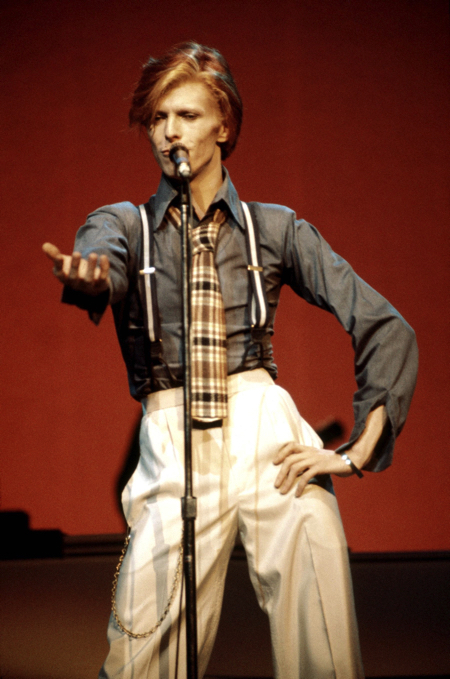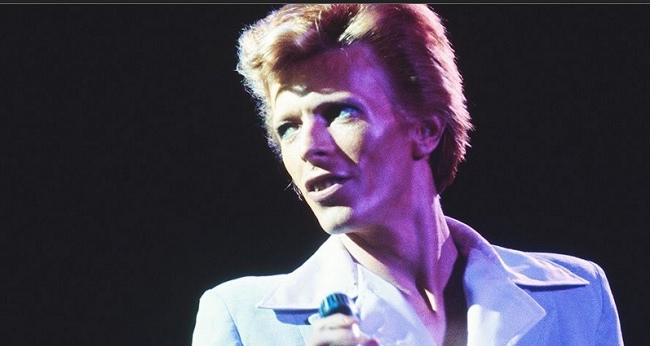David Bowie ranks as high in our electric church’s Afrofuturist pantheon of demiurges as Jimi Hendrix, George Clinton, and Miles Davis. That’s for his outrageous aristocratic style, not-just-skin-deep soul, badass brinksmanship, and all-around Alter-Negrocity. Not to mention the Starman’s own sui generis take on The Funk. Bowie remains that rarity — a white rock artist whose appropriations of black kulcha never felt like a rip-off but more like a sharing of radical and bumptious ideations between like-minded freaks.
It seems 1975 was the first year we saw a white man get busy on Soul Train, “The Hippest Trip in America.” Memory fails us as to whom Don Cornelius chose to lob over the color line before whom: Bowie with ”Fame” or Elton John, whose ”Bennie and the Jets” had become a boom box staple on the back of the school bus that year at D.C.’s Coolidge High. That same year, Average White Band dropped ”Pick Up the Pieces” on Soul Train, too. Doesn’t really matter, because of the three, Bowie had the funkiest track and the more charismatically alien presence — simultaneously the most culturally familiar and the most outright bizarre. The unabashed Brit who fell to Mother Africa and kept on stepping in rhythm and rhyme to his own quasar.
Bowie’s Soul Train appearance offers insight into his enigmatic ability to groove with The People and levitate above the fray, somewhere way beyond the pale. That visit to the Mecca of televised urban Terpsichore came two years after the two biggest pimp-thug cats at Coolidge High, Robert Parrish and his boy, came back from the Capital Center raving about seeing the Ziggy Stardust tour. This was before we knew about the deep and abiding relationship between louche hustlers and transgendered folks in the ’hood. Not long after Bowie dropped “Fame,” George Clinton begrudgingly tossed off this riposte on Mothership Connection’s ”P-Funk (Wants To Get Funked Up)”: ”I was down south, heard some main ingredients like Blue Magic, Doobie Brothers, David Bowie. It was cool — but can you imagine Doobie in your funk?”’ Cite the absence of any snap on Bowie, Starchile Clinton was giving the Starman some major props. Not least because Bowie inspired all of rock and funk ’n’ roll to go more glam, glittery, and avant-haute in the ’70s.
UNITED STATES – OCTOBER 01: RADIO CITY MUSIC HALL Photo of David BOWIE, performing live onstage on Philly Dogs Tour

(Photo by Steve Morley/Redferns)
All roads to Glamgnocity in that era lead back to Bowie — himself inspired by Jimi Hendrix. But Hendrix never got to realize rock theatricality as extravagantly as Bowie did — nor did the Voodoo Chile have a costume-designing wizard like Japan’s Kansai Yamamoto knitting away in his stage-couture shed.
Our ace boon Arthur Jafa likes to say that ”Andy Warhol was so white he was black.” Bowie (who played Warhol in Schnabel’s film Basquiat) was likewise so avant-garde he tipped over into the Avant-’Groid — that Afro-outré dimension where Little Richard and Sun Ra define how far out you can go and command love from the folk. Like Joni Mitchell — another unguilty pleasure of many boho blackfolk — Bowie double-crossed back over to black culture by being his own transcendently pan-everything creation. But not even Queen Mother Joni can say she provoked James Brown to copycat action twice in his career. JB was so blown away by Bowie’s ”Fame,” he cut his own carbon-copy track, ”Hot (I Need to Be Loved, Loved, Loved),” and, years later, when Bowie optioned his publishing for stock points, the Godfather of Soul got the news about how lucrative the deal proved and quickly followed suit. Bowie once said, “The secret to my success was I was always the second guy to come up with the idea.” All hip-hop junkies can relate: How you flip secondhand wisdom to make the meta go mega-pop takes genius, too. (FYI, the ”Fame” story is further complicated by the fact that Brown remembered Bowie’s co-writer Carlos Alomar playing the main riff at the Apollo years before — but chase down the long version here.
This reporter got to hang out with Bowie a few times in the aughts. Iman commissioned moi to write an essay for her cosmetics company’s catalogue. During our initial meeting, Iman leaned in with her cell phone and said, ”My husband wants to talk to you — he’s a big fan of your work.” Say WTF? It was truly the GTFOH gobsmack moment of a lifetime in music journalism. If only because, arrogant as we journos can be on the page, only an idiot thinks anyone of musical consequence actually reads our cantankerous sheet! Upshot is, because of that bizarre turnabout we got to get turnt out in person, as most were, by Bowie’s singular alchemy — utter nobility combined with an easygoing lack of pretension. Later came revelations about this highly irregular regular guy’s generosity of spirit.
During our first convo, Bowie related how he’d recently met P. Diddy — a man so impressed by Bowie’s handshake he inquired as to who Bowie’s trainer was. Whereupon the Thin White Duke informed Mr. Bad Boy, ”That grip isn’t from training, Puff. That’s from 40 years of trying to hold on to your money in the music business.” Talk about pulling a tyro’s coat tail.
Up close and personal, you also got to see how puppy-dog lovestruck Bowie’s goddess-worship of Iman was. Bowie’s curiosity also led him and Iman to truck down to CBGB one night to see this reporter’s then-wife, vocalist Tamar-Kali, rock out with her brand of Geechee Goddess Hardcore Warrior Soul. The couple also made their way to our good buddy Arthur Jafa’s very, very postmodern painting, sculpture, and performance opening in an off-the-beaten-path Soho gallery. There was nothing fake about Bowie’s passion for the people, art, and ideas that captured his imagination. If he was moved by your trip, he’d go the extra mile to show love as one of your fans, too. We also witnessed Bowie’s gangsta-husband come out at Tamar’s CBGB gig, when our 220-pound stage-diving homeboy Luqman Brown crash-landed in Iman’s lap. Bowie, sans security, turned Iceberg Slim–cold and snatched Luq off of his better half with the quickness while snapping ”Get off my wife” to our burly punk rock brother. Luq sheepishly slunk away, but we know that if it had been any other well-dressed white man courting a Somalian supermodel at CBGB back then, foul language and fisticuffs may have ensued. Even more impressive is that even after being rattled and smushed, Bowie and Iman stayed for the rest of Tamar’s set! Hardcore to the bone, yo.
Like anybody in the lily-white rock world of yon who sang, danced, and played saxophone, Bowie was beyond indebted to black culture. But much akin to Miles Davis, assimilating influences for Bowie meant he’d granted himself license to warp and mutilate those sweet inspirations in pursuit of self-renovation. This trait is abundantly evident on 1975’s Young Americans album. Bowie’s rapprochement with Philly Soul in Philly International’s home base, Sigma Sound, remains a watershed moment for our still-racialized world of American music-making. YA marked Bowie’s maiden voyage with Puerto Rican–born Apollo pit band guitarist Carlos Alomar, who’d become a studio and touring mainstay for the next decade. The album also features songwriting collaborations with emergent soul star and then-backing vocalist Luther Vandross. Shape of things to come: Who else but Bowie would later divine a crossroads for Nile Rodgers and Stevie Ray Vaughan to crew up on one of the dopest ’80s dance-floor anthems?
Who else but the same man would cede the spotlight to African American bassist/singer Gail Ann Dorsey during the concert versions of ”Under Pressure”? On Young Americans, you hear a white rock star who didn’t want to be read as a mere tourist in Blackonia but as a contributor, a collaborator, and ultimately a real comrade. This latter aspect was never more clear than when Bowie sat down with MTV host Mark Goodman in 1985 and forthrightly addressed the network’s then-glaring race problem:
David Bowie: Why are there practically no blacks on the network?
Mark Goodman: We seem to be doing music that fits into what we want to play on MTV. The company is thinking in terms of narrowcasting.
David Bowie: There seem to be a lot of black artists making very good videos that I’m surprised aren’t being used on MTV.
Mark Goodman: We have to try and do what we think not only New York and Los Angeles will appreciate, but also Poughkeepsie or the Midwest. Pick some town in the Midwest which would be scared to death by a string of other black faces, or black music. We have to play music we think an entire country is going to like, and certainly we’re a rock and roll station.
David Bowie: Don’t you think it’s a frightening predicament to be in?
Mark Goodman: Yeah, but no less so here than in radio.
David Bowie: Don’t say, “Well, it’s not me, it’s them.” Is it not possible it should be a conviction of the station and of the radio stations to be fair, to make the media more integrated?’
The Rolling Stones, Duran Duran, Bruce Springsteen, Talking Heads — no one, to that point, had so publicly challenged the segregated status quo at a network then offering rock artists free mass-market advertising. But from that unprompted interrogation of the race factor in MTV programming, we can infer that Bowie’s love for the most politically committed black artists — Nina Simone, James Brown, Stevie Wonder, Marvin Gaye, Gamble & Huff, Gil Scott-Heron, et al. — was more than lip service. Bowie got the memo that being a ride-or-die black-and-blue-eyed soul man meant putting your own career at risk in the name of cultural justice. That’s why we weren’t surprised to hear that his last album was majorly inspired by Kendrick Lamar’s To Pimp a Butterfly: ”I’m a black star / Not a rock star.’” Indubitably. And eternally. Down-by-law Bowie kept it 100 percent avant-’Groid until the wheels came off.


2.5
5